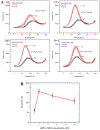Electric field-enhanced electrochemical CRISPR biosensor for DNA detection
- PMID: 34280652
- PMCID: PMC8453050
- DOI: 10.1016/j.bios.2021.113498
Electric field-enhanced electrochemical CRISPR biosensor for DNA detection
Abstract
DNA detection plays an important role in the rapid screening of cancers and early diagnosis of infectious diseases. Here, we developed a simple, versatile, electric field-enhanced (EFE), electrochemical CRISPR biosensor to detect DNA targets in a homogeneous solution phase. To improve the detection sensitivity, we applied a pulsed electric field to enrich nucleic acids on the electrode surface. The EFE electrochemical CRISPR biosensor takes advantage of the diffusivity difference between electrochemical oligonucleotide probes and CRISPR-cleaved probes toward a negatively charged working electrode, enabling simple and sensitive electrochemical detection of DNA without the need for complicated immobilization processing of electrochemical probes. Our developed CRISPR biosensor directly detects unamplified human papillomavirus-16 (HPV-16) DNA with a sensitivity of 1 pM. Further, the EFE electrochemical CRISPR biosensor coupled with recombinase polymerase amplification (RPA) successfully detects HPV-16 DNA in clinical samples. Thus, the EFE electrochemical CRISPR biosensor provides a simple, robust, and sensitive detection method for nucleic acid-based molecular diagnostics.
Keywords: CRISPR-Cas12a; Electrochemical DNA biosensor; Human papillomavirus (HPV)-associated cancer screening; Nucleic acid enrichment; Pulsed electric field.
Copyright © 2021 Elsevier B.V. All rights reserved.
Conflict of interest statement
Declaration of interests
The authors declare that they have no known competing financial interests or personal relationships that could have appeared to influence the work reported in this paper.
Figures





Similar articles
-
An ultrasensitive homogeneous electrochemical biosensor based on CRISPR-Cas12a.Anal Methods. 2021 Jul 29;13(29):3227-3232. doi: 10.1039/d1ay00725d. Anal Methods. 2021. PMID: 34235515
-
Universal and Programmable Rolling Circle Amplification-CRISPR/Cas12a-Mediated Immobilization-Free Electrochemical Biosensor.Anal Chem. 2021 May 25;93(20):7499-7507. doi: 10.1021/acs.analchem.1c00805. Epub 2021 May 13. Anal Chem. 2021. PMID: 33980009
-
Quencher-free CRISPR-based molecular detection using an amphiphilic DNA fluorescence probe.Biosens Bioelectron. 2025 Mar 1;271:117054. doi: 10.1016/j.bios.2024.117054. Epub 2024 Dec 9. Biosens Bioelectron. 2025. PMID: 39673958
-
Amplification-free nucleic acids detection with next-generation CRISPR/dx systems.Crit Rev Biotechnol. 2025 Jun;45(4):859-886. doi: 10.1080/07388551.2024.2399560. Epub 2024 Sep 22. Crit Rev Biotechnol. 2025. PMID: 39307577 Review.
-
[Application of CRISPR/Cas-based biosensors for detecting nucleic acid of pathogens].Sheng Wu Gong Cheng Xue Bao. 2021 Nov 25;37(11):3890-3904. doi: 10.13345/j.cjb.200679. Sheng Wu Gong Cheng Xue Bao. 2021. PMID: 34841793 Review. Chinese.
Cited by
-
Isothermal Technologies for HPV Detection: Current Trends and Future Perspectives.Pathogens. 2024 Aug 2;13(8):653. doi: 10.3390/pathogens13080653. Pathogens. 2024. PMID: 39204253 Free PMC article. Review.
-
Electrochemical Duplex Detection of E2 and E6 Genes of Human Papillomavirus Type 16 and Determination of Physical Status in High-Risk Cervical Carcinoma.J Med Virol. 2025 Mar;97(3):e70299. doi: 10.1002/jmv.70299. J Med Virol. 2025. PMID: 40071579 Free PMC article.
-
CRISPR for companion diagnostics in low-resource settings.Lab Chip. 2024 Oct 9;24(20):4717-4740. doi: 10.1039/d4lc00340c. Lab Chip. 2024. PMID: 39268697 Free PMC article. Review.
-
In situ formation of fluorescent non-conjugated polymer dots for α-glucosidase activity assay and inhibitor screening.Mikrochim Acta. 2025 Aug 8;192(9):569. doi: 10.1007/s00604-025-07417-1. Mikrochim Acta. 2025. PMID: 40779177
-
Solid-Phase Collateral Cleavage System Based on CRISPR/Cas12 and Its Application toward Facile One-Pot Multiplex Double-Stranded DNA Detection.Bioconjug Chem. 2023 Oct 18;34(10):1754-1765. doi: 10.1021/acs.bioconjchem.3c00294. Epub 2023 Oct 2. Bioconjug Chem. 2023. PMID: 37782626 Free PMC article.
References
-
- Bown MR, Meinhart CD, 2006. Microfluid. Nanofluidics 2, 513–523.
-
- Bruch R, Baaske J, Chatelle C, Meirich M, Madlener S, Weber W, Dincer C, Urban GA, 2019. Adv. Mater 31, 1905311. - PubMed
MeSH terms
Substances
Grants and funding
LinkOut - more resources
Full Text Sources
Other Literature Sources

